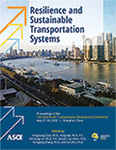13th Asia Pacific Transportation Development Conference
Application of Optimized BP Network in Bogie Condition Monitoring
Publication: Resilience and Sustainable Transportation Systems
ABSTRACT
The research and analysis of the technology of vehicle bogie condition monitoring combined with the basic principle of BP network is applied to the condition monitoring of vehicle bogies. The genetic algorithm is used to optimize the BP network, establish the optimal weight and threshold, and establish an ideal BP network model to complete the state monitoring. The dynamic model of the bogie is established by the knowledge of the dynamics of the rail vehicle, and the irregularity of the rail is used as an external stimulus to simulate the state of the vehicle running. Test analysis using an optimized BP network. It was found that the optimized BP network is more stable and accurate. With the continuous development of railway transportation, rail transit has occupied a very important position in the public transportation system. The safety and comfort of rail vehicles is an important factor affecting their development. The suspension system is a key component of the vehicle's travel department, and the performance of the suspension system directly affects the safety and comfort of the vehicle. The online real-time fault condition monitoring of the suspension system plays an important role in the safe and stable operation of the vehicle. Therefore, it is a hot research topic for domestic and foreign scholars to seek real-time and reliable suspension system fault diagnosis methods. At present, there are many fault diagnosis methods for rail vehicle suspension systems at home and abroad. There is a vehicle suspension system fault diagnosis based on IMM algorithm, vehicle suspension system fault diagnosis based on observation method, etc. The fault can only be alerted, and the fault cannot be further determined. Artificial neural network algorithm is a discipline developed on the basis of modern neurology. BP neural network is the most widely used. It adopts parallel distributed processing, learning and memory function, and nonlinear mapping ability, which can perform multi-fault identification, complex pattern recognition, etc., achieved good results in the fault diagnosis system. The combination of genetic algorithm and BP neural network algorithm realizes the recognition of corresponding faults from nonlinear and non-stationary signals. The walking part is an important part of the rail vehicle. It plays the role of carrying, pulling, running, and braking. It is a key link to determine the safety and dynamic performance of the train. This paper establishes a simulation model of orbital dynamics and performs data acquisition and processing. Genetic algorithm is used to optimize BP neural network algorithm for fault diagnosis of key components of vehicles.
Get full access to this article
View all available purchase options and get full access to this chapter.
REFERENCES
Cheng, C., and Yue, F. (2014) “Research on the method of monitoring vehicle faults by using the vibration acceleration of bogies.” Foreign railway vehicles, 5, 36-41
Guo, S. P. (2014) “Research on Fault Diagnosis of Urban Rail Train Suspension System and Its Engineering Implementation.” Beijing Jiaotong University.
Tsunashima, H., & Mori, H. (2010, October). “Condition monitoring of railway vehicle suspension using adaptive multiple model approach.” ICCAS, 2010,584-589. IEEE.
Lei, H., Sufang, Z., & Liqing, N. (2016). “The Teaching Research on Matlab Modeling and Simulation of Vertical Vibration for Rail Vehicle.” China Modern Educational Equipment, (7), 27.
Li, P., & Goodall, R. (2004). “Model-based condition monitoring for railway vehicle systems.” Control 2004 .
Staszewski, W. J., & Worden, K. (1997). “Classification of faults in gearboxes—pre-processing algorithms and neural networks.” Neural Computing & Applications, 5(3), 160-183.
Xu, L. F., He, D. Q., & Miao, J. (2015) “Research on fault diagnosis method for suspension system of urban rail transit vehicles.” Equipment manufacturing technology, 2015(7), 1-5.
Wu, M., and Shen, G. (2013) “Research on Early Warning Scheme of Mechanical Failure of Rail Vehicles.” Journal of East China Jiaotong University, 30(1), 32-35.
Yang, J., Zhan, J., & Zhang, J. C., et al. (2014) MATLAB neural network 30 cases. Beijing: Electronic Industry Press.
Ye, Z. J. (2016) “Theoretical Study on Safety Monitoring and Early Warning Algorithm for Rail Vehicles.” Shanghai: Shanghai University of Engineering and Technology.
Hayashi, Y., Tsunashima, H., & Marumo, Y. (2006, October). “Fault detection of railway vehicles using multiple model approach.” 2006 SICE-ICASE International Joint Conference, 2812-2817. IEEE.
Wang, Y., Mao, Z., & Jiang, B. (2014, May). “Observer-based fault detection for rail vehicle suspension systems.” The 26th Chinese Control and Decision Conference (2014 CCDC), 2863-2868. IEEE.
Zhang, B. (2007) “Theory and Analysis of Safety Detection in Key Parts of Trains.” Chengdu: Southwest Jiaotong University.
Zhong, B. L., and Huang, R. (1997) Mechanical Fault Diagnosis. Mechanical Industry Press.
Information & Authors
Information
Published In
Resilience and Sustainable Transportation Systems
Pages: 157 - 165
Editors: Fengxiang Qiao, Ph.D., Texas Southern University, Yong Bai, Ph.D., Marquette University, Pei-Sung Lin, Ph.D., University of South Florida, Steven I Jy Chien, Ph.D., New Jersey Institute of Technology, Yongping Zhang, Ph.D., California State Polytechnic University, and Lin Zhu, Ph.D., Shanghai University of Engineering Science
ISBN (Online): 978-0-7844-8290-2
Copyright
© 2020 American Society of Civil Engineers.
History
Published online: Jun 29, 2020
Authors
Metrics & Citations
Metrics
Citations
Download citation
If you have the appropriate software installed, you can download article citation data to the citation manager of your choice. Simply select your manager software from the list below and click Download.
